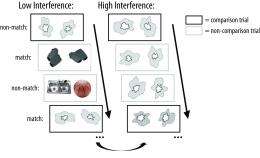Alzheimer's sufferers may function better with less visual clutter

Psychologists at the University of Toronto and the Georgia Institute of Technology – commonly known as Georgia Tech – have shown that an individual's inability to recognize once-familiar faces and objects may have as much to do with difficulty perceiving their distinct features as it does with the capacity to recall from memory.
A study published in the October issue of Hippocampus suggests that memory impairments for people diagnosed with early stage Alzheimer's disease may in part be due to problems with determining the differences between similar objects. The research contributes to growing evidence that a part of the brain once believed to support memory exclusively – the medial temporal lobe – also plays a role in object perception.
"Not only does memory seem to be very closely linked to perception, but it's also likely that one affects the other," said Morgan Barense of the University of Toronto's Department of Psychology. "Alzheimer's patients may have trouble recognizing a loved one's face not just because they can't remember it but also because they aren't able to correctly perceive its distinct combination of features to begin with."
The research team tested patients with mild cognitive impairment (MCI) – a disorder commonly thought to be a precursor to Alzheimer's disease – on their ability to determine whether two rotated side-by-side pictures were different or identical.
In one set of trials, many pairs of photos of blob-like objects were shown. These were classified as high-interference trials as the photos varied only slightly when they weren't a perfect match, either by shapes or fill pattern. As expected, MCI patients struggled greatly to identify identical pairings.
In low-interference trials, the blob-like objects were interspersed with photos in which non-matches were more extreme and varied widely. For example, a picture of a butterfly was shown next to a photo of a microwave. Interspersing the very similar blob-like objects with photos of dissimilar objects greatly reduced the amount of interference.
"Minimizing the degree of perceptual interference improved patients' object perception by reducing the number of visually similar features," said lead author of the study Rachel Newsome, a PhD candidate in U of T's Department of Psychology.
The findings suggest that, under certain circumstances, reducing "visual clutter" could help MCI patients with everyday tasks. For example, buttons on a telephone tend to be the same size and color. Only the numbers are different – a very slight visual difference for someone who struggles with object perception. One solution could be a phone with varying sized buttons and different colors.
The researchers, which also included Georgia Tech psychology professor Audrey Duarte, administered the same tests to people at risk for MCI who had previously shown no signs of cognitive impairment.
"They performed the same as those with MCI, suggesting that the perception test could be used as an early indicator of cognitive impairment," said Barense. "It provides further support for the idea that any damage to a small area of the medial temporal lobe – especially the perirhinal cortex – affects perception as much as it does memory."
More information: The study is reported in the paper "Reducing perceptual interference improves visual discrimination in mild cognitive impairment: Implications for a model of perirhinal cortex function" in the October special edition of Hippocampus titled Perirhinal Cortex: At the Crossroads of Memory and Perception.

















